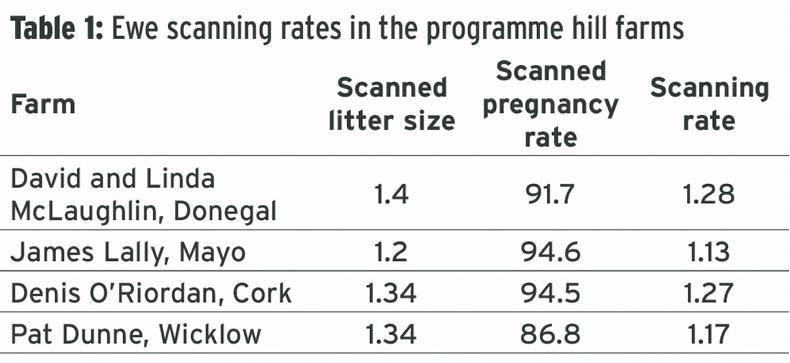Lambing in the hill flocks participating in the Teagasc BETTER farm sheep programme is due to commence over the next week. Programme adviser Frank Campion reports ewe condition benefiting from the mild weather over the winter, with all the flocks in a pretty good position for lambing.
“The farms are happy with how ewes performed over the winter. Ewes are not over-conditioned, but at the same time, the mild winter has ensured ewes are not shook, with all sheep in a healthy state heading into lambing.”
Scanning results, as detailed in Table 1, were more variable this spring, with higher barren rates than last season. This is likely to be contributed to by a difficult year for many of the flocks in 2016. Pat Dunne’s flock had a higher barren rate and this is due to an underlying health issue.
Twins have been separated from single-bearing ewes for five to six weeks at this stage to allow preferential feeding to take place. In most cases, twins have been brought to lowland areas, while singles were returned to the hill until closer to lambing, with the exception of the Cork flock of Denis O’Riordan.

Feeding rates for single-bearing ewes have been built up in general to 0.5kg for the final two weeks of pregnancy, while twins have been built up to 0.7kg to 0.8kg. All flocks are lambing single-bearing ewes outdoors, with twins outdoors and indoors.
Frank explains there is a strong focus across all the Teagasc BETTER farm sheep flocks on recording and analysing flock mortality, along with setting up the flock to monitor animal performance. All lambs are tagged and correlated to their dam, with lambing factors such as ewes with poor mothering ability, low milk yield or any other relevant issues documented. Recording is being carried out 18 hours to 24 hours after birth, with farms operating various recording procedures.
For example, David and Linda McLaughlin generally tag and record each morning. Lambs born on the previous day are tagged and, along with their ewes, moved to another field. This also serves to reduce the number of lambs present in the lambing area and facilitates easier feeding of pregnant ewes.
Depending on grass supplies, concentrate supplementation will continue for the first few weeks after lambing, with twin suckling ewes receiving preferential treatment.
Six-week weights
Ewes and lambs will generally be retained on the lowland areas for a few weeks after lambing, with some flocks where ewes can be flocked easily for weighing lambs at six weeks returning ewes with single lambs to hill grazing after two to three weeks.
Forty-day weights give a good indication of ewe milk yield and, along with the lambs’ own performance, give invaluable information for selecting replacements.
Recording is also a vital aspect of flocks that are pure-breeding to identify the best-performing breed lines and avoid the risk of inbreeding in the future.
New participant
Frank also reports the addition of a new hill farmer, Francis Gonley, who farms a short distance outside Sligo. The main emphasis once lambing has finished will be the development of a three-year farm plan.
This will focus on increasing output through better breeding and nutrition at key time frames during the year, improved grazing management and health control.






 This is a subscriber-only article
This is a subscriber-only article







SHARING OPTIONS: